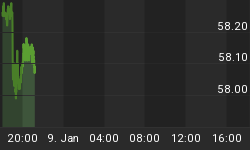The bulls have been firmly in control since the European Central Bank (ECB) induced rally off the December 19 low in stocks. However, last week's capitulation selling in the VIX and current divergences between the S&P 500 and Transports have opened a crack in the bearish door. We believe a news item, such as the lack of progress made at this weekend's G20 summit, is needed to give the bears some traction.
The VIX measures implied volatility for the S&P 500 over the next 30 days. When the VIX is at low levels, it tells us the market is not concerned about a volatile pullback or negative headlines. Therefore, the VIX is another way to monitor market sentiment. Sentiment can be a powerful contrary indicator when the level of bullishness reaches extremes (or when the VIX reaches extremes).
The VXX ETN has a strong correlation to the VIX. VXX dropped 8.32% on February 23 telling us we may be nearing the level of maximum complacency in terms of bullishness. A strong reversal this week in VXX would add to our concerns relative to a possible pullback in stocks.

The video below mainly focuses on the current oversold nature of the VIX and the possible ramifications for stocks. Recent DeMark trend exhaustion signals for the VIX are discussed within the context of historical signals. Other video topics include a bearish divergence in the Transportation Average and the next round of money printing in Europe.
After you click play, use the button in the lower-right corner of the video player to view in full-screen mode. Hit Esc to exit full-screen mode.
The aforementioned bearish divergence between the Dow Jones Transportation Average and the S&P 500 is shown below. Note how peaks in the S&P 500 (top) and Transports (bottom) have tended to occur in unison in recent months (see blue-dotted vertical lines). The current market breaks the pattern with the Transports already experiencing a 5.5% pullback since early February (see red box right side).

The video above covers the always-important calendar of events in Europe. The most important and potentially market moving event is Wednesday morning's announcement of the European Central Bank's (ECB) second round of unlimited three-year loans for banks. While the bias for money-printing exercises is always bullish, a smaller than expected tapping of the ECB's generous facility could disappoint markets addicted to central bank liquidity.
As we outlined in a December video, the debt levels in Europe will most likely remain problematic for investors for years to come. However, the strong market trends we cited last week are often associated with brief corrections followed by more upside.
The market's bias near month-end also tends to be bullish, which means any pullback could be muted early in the week. Our base case looks for an S&P 500 pullback in the range of 5.5% to 11.0%, with a more shallow correction being the higher probability outcome. Should a pullback occur, we will be looking at leading markets and sectors as possible buy candidates, including technology (QQQ), homebuilders (XHB), consumer discretionary (XLY), small caps (IJR), and mid-caps (IJK). During any pullback, a spike in VXX is also worth keeping an eye on.
















